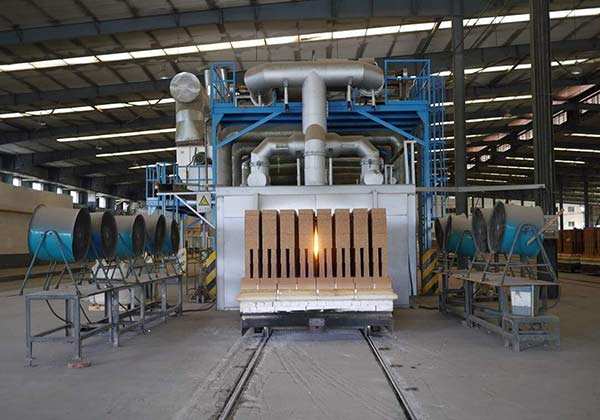
Straight-shaped refractory bricks whose length and width exceed the size of standard bricks.
Refractory materials are basic materials that serve high-temperature technology and are extremely closely related to various industrial kilns. Várias estradas de fornos industriais diferem devido ao seu uso e condições de uso. The requirements for refractory materials, the basic materials that make up its subject, are also different.
Different types of refractories also exhibit different basic characteristics due to differences in chemical mineral composition, Microestrutura, and production processes. Portanto, in the process of understanding and studying refractory materials, it is necessary to describe their basic properties and general characteristics of refractory materials. Then, PER Refractories is introduced for you.
De um modo geral, materiais refratários: are inorganic non-metallic materials with refractories above 1580℃. It includes natural ores and various products made by a certain process according to certain purpose requirements. With certain high-temperature mechanical properties and good volume stability, is a variety of high-temperature equipment necessary for the material.
1. By chemical composition: refractory materials can be divided into acidic, alcalino, and neutral.
2. Refratários: can be divided into universal refractories (1580~1770°C) advanced refractories (1770~2000°C) special refractories (above 2000°C) and super refractories (greater than 3000°C) four categories.
3. Divided by processing and manufacturing process: can be divided into firing products, fusion casting products, and non-burning products; divided by use: can be divided into a blast furnace with, blast furnace with, converter with, continuous casting with, glass kiln with, cement kiln with refractory materials.
4. Divided by appearance: can be divided into refractory products, refractory clay, and irregular refractory materials.
5. The shape and size can be divided into standard, general, special, special, and super special products.
6. According to the molding process: can be divided into natural rock cutting and sawing, mud pouring, plastic molding, semi-dry molding and vibration, pounding, molten cast molding, e outros produtos.
7. By chemical – mineral composition: can be divided into aluminosilicate (tijolos de argila, tijolos de alta alumina, tijolos semi-sílica) sílica (tijolos de sílica, fused quartz firing products) magnesium (tijolos de magnésio, tijolos de alumínio e magnésio, magnesium chrome bricks); carbon (tijolos de carbono, graphite bricks) dolomite, zircon, special refractory products (high-purity oxide products, refractory compound products, and high-temperature composite materials).
1. To adapt to the requirements of high-temperature operation, should have a sufficiently high temperature without softening, not melting.
2. Able to withstand the load of the kiln and the stress applied during operation, and at high temperatures without loss of structural strength, softening deformation, and collapse, usually expressed in terms of load softening temperature.
3. The volume is stable at high temperatures, and the kiln masonry or cast body does not crumble due to excessive expansion of the product or crack due to excessive shrinkage, reducing the service life. Typically measured by the coefficient of linear expansion and retired shrinkage.
4. Refractory material is greatly affected by the operating conditions of the kiln, rapid temperature changes and uneven heating make the furnace body easy to damage. Portanto, it is required to have a certain degree of thermal shock resistance.
As there are many types of refractory bricks, today PER Refractory Factory’s technician first introduces you to straight refractory bricks.
Straight refractory brick refers to the straight parallel six-sided refractory brick body composed of only three dimensions: comprimento, width, and thickness.
The brick surface formed by the length and width is called the large surface, the surface formed by the length and thickness becomes the side, and the brick surface formed by the width and thickness is called the end surface.
1. Standard refractory brick
Straight brick with a length of 230mm, a width of 114mm, and a thickness of 65mm (or 75mm), por exemplo, high alumina brick for general industrial furnace.
2. Three-fourths long brick
The length is three-quarters of the standard brick (172milímetros), and the width and thickness are the same as the standard brick staggered straight brick.
3. Half of the long brick
The length is one and a half times the standard brick (345milímetros), width and thickness are the same as the standard refractory brick straight brick.
4. Double-length brick
Double the length of the standard brick (460milímetros), width and thickness are the same as the standard refractory brick straight brick.
5. Half-width brick
The width is half of the standard brick (172milímetros), and the length and thickness are the same as the standard refractory brick staggered straight brick.
6. Half-thick thin brick (also known as half of the piece)
The thickness is half of the standard brick, and the width and length are the same as the standard refractory brick straight-shaped brick.
7. Double wide brick (square brick)
The width is two times the standard brick (230milímetros), and the length and thickness are the same as the standard refractory brick straight-shaped brick (also known as a square brick).
8. Extended brick
Straight-shaped refractory bricks whose length and width exceed the size of standard bricks.
The quality of the refractory material depends on its nature, it is the standard of criteria for evaluating the quality of products. PER Refractories produces a variety of straight-line refractory bricks and shaped refractory bricks. You can always contact us for more cheap refractory bricks.
Desde outubro, os preços da alumina continuaram a subir, and China's largest bauxite importer - a…
Primeiro, Tijolo de alta alumina: The Leader In High Temperature Refractories As a leader in high-temperature…
The application of refractory bricks in the kiln immediately endangers the operation rate of the…
Analysis Of The Causes Of Common Quality Problems In Tunnel Kiln Construction And Measures To…
Corundum quality refractory castables are made from corundum to the new jade refractory insulation material…
Análise de matérias-primas refratárias de alumínio-silício Prof. Li Yong of the University of Science and…